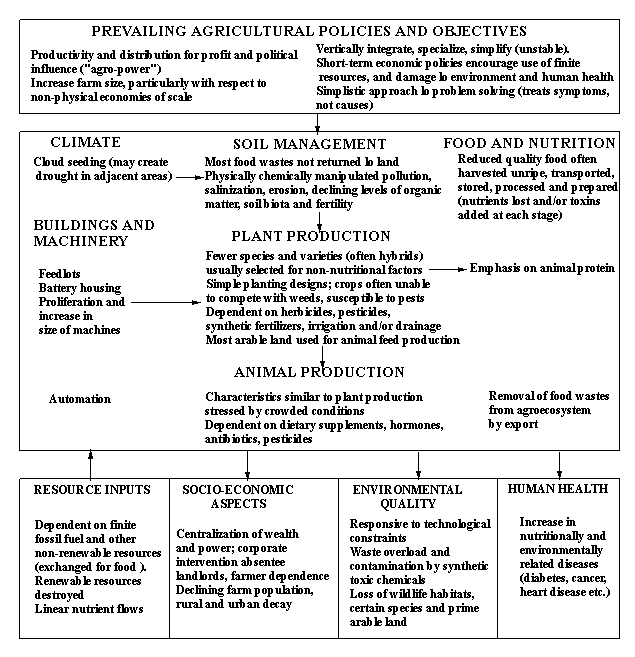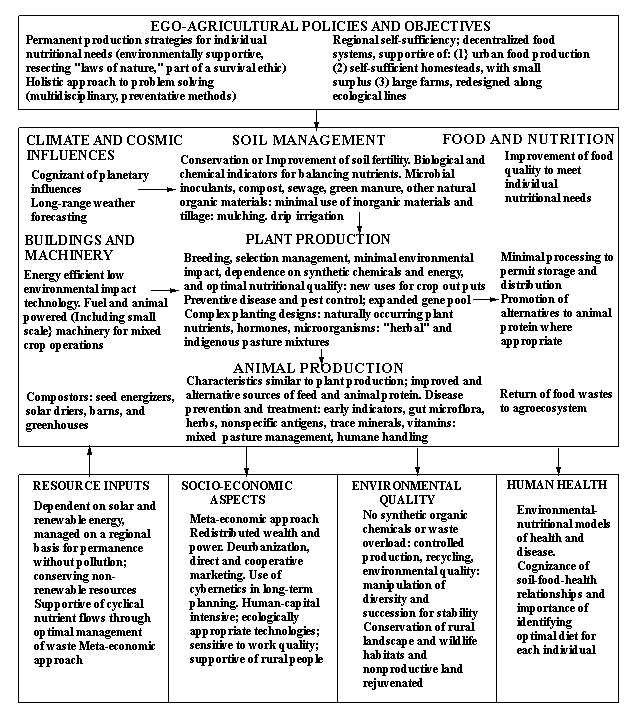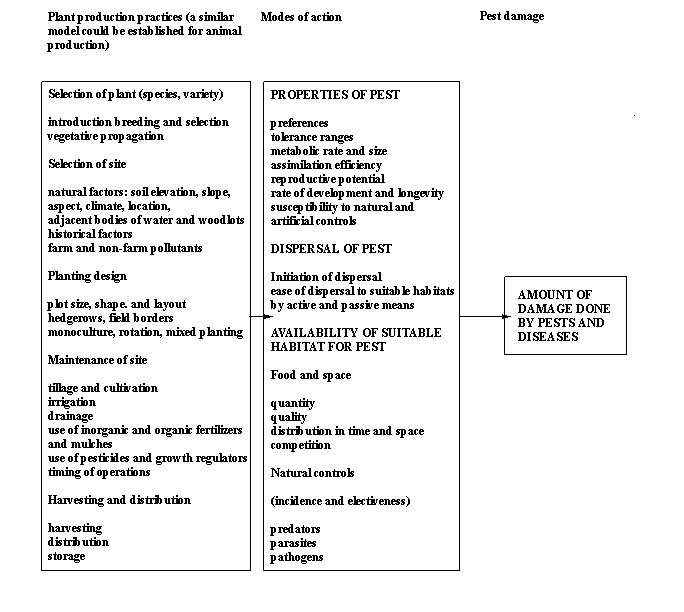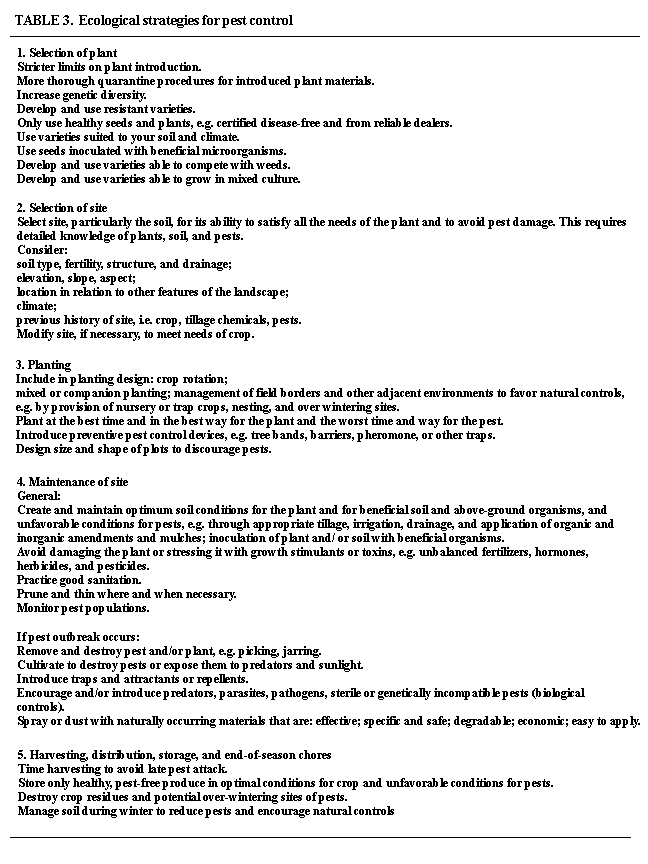
Department of Entomology, Macdonald College, Que.
GOAL
To interest the reader in ecology and provide sufficient information to:
1. compare alternative strategies for feeding people by means of ecological criteria;
2. suggest ecologically sound strategies for providing Canadians, and those served by our aid programs, with access to the necessary foods (or resources to obtain them) to achieve optimal physical and mental health.
BEHAVIORAL OBJECTIVES
After reading this paper you will be able to define ecology in words or diagrammatically and list:
1. two of the four laws of ecology discussed below;
2. two implications of these laws for our food system;
3. two of the seven goals of a normative food policy;
4. five ecological strategies for food production in Canada that should be implemented, expanded, or supported by additional research funding;
5. three benefits of the ecological approach.
INTRODUCTION
In his fascinating book "Life on a little known planet" Professor Howard Evans ( 1970) states that "ecology . . . is truly the science of tomorrow" and "productivity is basically a problem in ecology and . . . must be considered on a global scale." In this paper I will examine the meaning of these statements.
Ecology is classically defined as the study of the home of organisms, and ecologists have focused on the interrelationships between organisms and their living and nonliving environment. Reference to current literature, however, shows that ecology could now be defined as the relationship between everything and everything; it tends to emphasize a holistic, long-term view, and is often concerned with complex relationships among influencing variables and with the prediction of future events by means of on-line computer models.
INDUSTRIAL AGRICULTURE: PROBLEMS AND ALTERNATIVES
Although it is true that food production per area and per farmer effort has dramatically increased over the past 50 years, so have the levels of inputs and associated environmental impact, while energy efficiency and the capital within the system have declined. Other features of modern agriculture have negative implications are shown in Figure 1.
These developments within agriculture are not unique, but are part of our changing relationship with our support environment; from being, to some extent, at its mercy, to exercising considerable control over it, for instance through the use of fertilizers, pesticides, and powerful machinery. If we continue to increase our dependence on these inputs, crises will undoubtedly result as finite resources become scarce and environmental damage thresholds are reached.
It is the view of many ecologists that we must develop a new postindustrial relationship with our support environment, including a renewable resource base, the use of ecological strategies, and an emphasis on individual real needs as opposed to mass-manipulated wants.

LAWS OF ECOLOGY, ECOLOGICAL AGRICULTURE AND A NORMATIVE FOOD POLICY
One approach to establishing an alternative ecological agriculture is to examine natural ecosystems for clues to the laws governing their operation. Four such laws relevant to food production are listed, with their implications, in Table1. Such laws constitute the criteria against which alternative food production strategies must be tested.
TABLE 1. Laws of nature in relation to food production

TABLE 2. primary goals of a normative Canadian food policy

An example of an alternative ecological agriculture, based on these laws is given in Figure 2.

Clearly such an alternative could not be reached by extrapolation but requires normative planning, that is, defining our long-term goals and working backwards from them to the present (Lovins 1976). The goals of such normative, ecological approaches focus on health, permanence, efficiency, environmental quality, and fair rewards for those employed within the food system. These goals are long-term and comprehensive, emphasizing real needs and respecting biochemical constraints and the complex, cyclical character of the natural environment. Such approaches are likely to reveal influencing variables and alternative strategies that would not be apparent under present approaches; they are also able to predict future events more accurately.
It is relevant first to review how soil is formed. The process requires two material inputs: rock (the earth's crust), and dead organic matter, these being converted to soil largely through the process of decomposition.
There is certainly no shortage of rock and, in temperate countries there should be no shortage of dead organic matter, as the optimum temperature for its production is nearer the annual mean temperature than is the optimum temperature for its decomposition. This, in fact, is the main reason why we find a deep litter layer in most of our forests, whereas there is usually no litter layer in lowland tropical forests. The biological decomposition process is carried out largely by bacteria and fungi. However, at least six factors limit their activity (food, space, dispersal, competition, cropping, and senescence). The soil fauna play an important role because, through their feeding and movement, they are continually removing these limiting factors, particularly through their ability to disperse the microflora. Thus, if certain members of the fauna are killed or reduced by agricultural practices, the activity of the bacteria and fungi that rely on those particular species will decline.
Our detailed knowledge of these processes is poor, but it is sufficient to know that by taking into account the organisms in the soil, and catering to their needs, soil fertility can be built up and maintained. The primary requirement is that organic materials taken from the land be returned. This follows from the law of ecology concerning cycles.
Rather than forcing the resident "decomposer industry" out of business by applying synthetic chemical fertilizers, or killing some of them by applying biocides, we should be investigating their productive potential within each soil type and developing management strategies whereby any potential can be realized. Such strategies are likely to save money and energy, and avoid damage to the support environment and to human and livestock health. This contrasts with our current approach, which involves the removal of several dozen minerals at harvest time followed by the replacement of only a few of them as chemical fertilizers.
Pests and diseases are symptoms of poor management. Pesticides, like antibiotics and drugs, have generally been regarded as "magical bullets" that can eliminate problems. But the real situation is that we do not suffer from pests because of a deficiency of pesticide in the environment, just as we do not get a headache because of a deficiency of aspirin in the blood.
The use of pesticides and antibiotics to control pests and pathogens leads to the development of a long list of serious secondary problems (resistance, damage to beneficial organisms, secondary pest outbreaks, persistence and dispersal, concentration up the food-chain, and sublethal effects).
Moore (1967) has pointed out that we really only have three alternatives with respect to controlling pests: continual development of new pesticides as pests become resistant; exclusion of pests in enclosed, artificial environments (the science fiction solution); and prevention by modifying our agroecosystems. The pesticide approach predominates largely because most of the costs (such as environmental and human health) are not taken into account in our cost-benefit analysis. As a member of the British Labour party once explained, this encourages "private, short-term gain at public long-term expense."
In order to treat pest problems at the causal level, it is necessary to examine more closely the relationships between agricultural practices and pest damage. This approach has been used to generate strategies. These must be designed for each situation; consequently the particular strategies employed should ideally be selected by the farmer himself, or someone else who is familiar with the area and the operation of the particular farm. Although these approaches could be considerably refined if the money and effort currently directed toward pesticides were used to develop such ecological strategies, I believe that most pests could be brought below the economic threshold with the knowledge that we possess right now; we just need to use it! The history of pest control shows that this ecological approach comprises the only means of achieving long-term control of pests and diseases (Moore 1967). It is significant that the use of pesticides has no, decreased the percentage loss of crops to pests; it remains at about 33%. (May 1977).
One approach to understanding what is happening to food quality is to propose a deductive model and check whether the evidence supports or contradicts it. The model is based on the concepts of Roger Williams (1971), who argues that cells, and therefore organisms, can only suffer from two nutritional problems: malnutrition and poisoning. Malnutrition occurs when certain nutrients are missing or are not in balance, poisoning when toxins are present. Thus, in order to understand the influence of our food system on food quality we must examine how food production and handling practices might lead to loss of certain essential factors and the addition of various toxins.
Plant production is comprised of the following stages: plant and site selection, planting, maintenance, and harvesting. At every stage of production there is a high chance that nutrients will be lost or toxins added. Plants are selected primarily on the basis of productivity, size, shape, cosmetic appearance, and machine pick, ability, factors that have nothing to do with food quality. Selection for these characteristics is likely to lead to a reduction in food value.
A preferable strategy would be to select plants to meet the needs of local populations. More emphasis should be placed on nutritional quality and palatability, as well as resistance to pests and disease, ability to compete with weeds, suitability to local conditions, ability to improve soils, and a low dependence on energy inputs (such as fertilizers, pesticides, and machinery).
Site selection is currently based on climatic and economic factors. Soils are manipulated by tillage and the application of fertilizers and pesticides in order to grow the most economically rewarding crop, regardless of the longterm effects on the soil or the long- or short-term effects on nutritional quality.
The practice of continuous cropping removes many nutrients. Usually one, two, or three of them (N, P, or K) are replaced on the misunderstanding that this will replenish the soil. The use of unbalanced fertilizers may also result in plants being deficient in certain essential amino acids. Crops also remove other essential and trace minerals, which are not returned to the soil in most fertilizer programs. The soils become more deficient in these minerals with time, resulting in plants that are not only lacking the minerals but also those vitamins that depend on the minerals for synthesis.
Most pesticides are synthetic organic poisons that have no counterpart in nature and consequently pose a considerable problem for our bodies, which must detoxify or eliminate them. The crop is often harvested before ripening so that it may be conveniently picked by machine; hence it is likely to be of inferior nutritional quality. Food handling involves the addition of numerous chemicals and loss of certain nutrients. Cooking usually results in a further loss of nutrients.
IMPLEMENTING THE PROPOSED CHANGES
Changing from conventional strategies will not be easy. Modern agriculture has become dependent on simplistic chemical solutions to problems, just as heroin addicts have become dependent on their drug. Neither pesticides nor stimulatory drugs treat problems at the causal level.
Because of the addictive nature of the problem, the implementation of alternative strategies will require an enormous cooperative effort involving the general public (consumers), industry and commerce (including producers), researchers (in federal and provincial governments, universities, and industry), communicators (media people, educators, and extension agents), and governments (federal, provincial, and local). The alternative to cooperation is to respond to the crises that will undoubtedly occur with increasing frequency if we continue with the kinds of solutions to problems that are exemplified by the use of agricultural chemicals (Whiteside 1977). Some of the strategies available to governments are laws, regulations, standards, codes, taxation, incentives, education, models, research and development, public participation, policy and planning.
FIGURE 3. Relationships between plant production and pest damage

TABLE 3. Ecological Strategies for pest control

Evans, H. E. Life on a little known planet. London: Deutsch; 1970.318 pp.
Lovins, A. Exploring energy-efficient futures for Canada. Conserver Soc. Notes 1(4), 5-16; 1976.
May, R. M. Food lost to pests. Nature 267(5613), 669-670; 1977.
Moore, N. A synopsis of the pesticide problem. Adv. Ecol. Res. 4, 75-129; 1967.
Williams, R. J. Nutrition against disease: Environmental prevention. New York: Pitman; 1971. 370 pp.
Whiteside, T. The pendulum and the toxic cloud. The New Yorker, July 25, 1977. pp. 30-55.
Aubert, C. L'agriculture biologique. 2nd ed. Paris: Le courrier du livre; 1972. 255 pp. Good review of ecological agriculture in France. 92 refs.
Balfour, Lady Eve B. The living soil and the Haughley experiment. London: Faber
Faber; 1975. 383 pp. A reprint of her 1948 book and a report of 32 years comparison of organic, mixed, and chemical sections of a farm at Haughley, England, in terms of productivity, cost, nutritional quality, and animal health. Results show the superiority of ecological approaches and stress the relationships between soil and health. 54 refs. and numerous footnotes in text.
Bookchin, M. Our synthetic environment. 2nd ed. New York: Harper & Row; 1974. 305 pp. One of the clearest statements of the problems we face in agriculture, human settlements, and health. Includes useful section on soil fertility and nutrition, agroecosystems, and chemicals in agriculture and food processing. 33 pp. refs. See also his Post-scarcity anarchism (1971), and his chapter in Merrill's Radical agriculture (1976).
Dasmann, R. F.; Milton J. P.; Freeman, P. H. Ecological principles for economic development. London: Wiley; 1973. 252 pp. A brave response to the problems raised in Farvar and Milton's The careless technology ( 1972). Most examples are from the tropics and semitropics but many of the concepts are applicable to the temperate zone. Refs. after each chapter. See also Dasmann's The conservation alternative (1975).
Dickey, L. D., ed. Clinical ecology. Springfield, IL: Thomas; 1976. 807 pp. A small group of American and Canadian physicians are having remarkable success managing a wide range of diseases and emotional states by food elimination and rotational diets and by controlling their exposure to offending chemicals. This book of 80 chapters by 45 authors is the most comprehensive work on this topic to date and is included in this bibliography because of its far-reaching implications for agriculture. Refs. after each chapter.
Geno, B. J.; Geno, L. M. Food production in the Canadian environment. Science Council of Canada. Study on population, technology and resources. Perceptions 3: Supply and Services Canada, Ottawa, Ont. 1976. 66 pp. A revised version of Larry's Report to Environment Canada: Energy, agriculture, and the environment (1975). Presents a holistic view of Canadian agriculture, discussing its basis, problems, and potentials for an ecologically supportive food production system. Summarizes useful data on energy use in agriculture. Notes for each chapter.
Hall, R. H. Food for nought. New York Random House; 1974. 292 pp. A searching discussion of the decline in nutrition, tracing it back to industrial agriculture and food processing. 438 refs.
Merrill, R., ed. Radical agriculture. New York: Harper and Row; 1976. 459 pp Anthology of articles by activists in rural restoration. Land reform, agribusiness, urban/rural alliances, new technologies, etc. Refs. after each chapter.
Messerschmitt, H. et al. L'encyclopédie permanente d'agriculture biologique. Paris: Editions Bédard; 1974. A two-volume, beautifully illustrated anthology. Full of information, stressing balance between ecology, technology, and economics. Many refs throughout.
Schumacher, E. F. Small is beautiful: A study of economics as if people mattered. London: Abacus; 1974. 255 pp. Argues that we are getting out of equilibrium because we are applying only one test to everything we do: money, profits, and therefore giant operations. We have treated agriculture as an industry, concerned only with producing food and fiber, and in so doing have neglected its three primary goals-health, beauty, and permanence. If we fail to develop a meta-economic approach, which takes these things into account, we will follow the other 10 to 30 civilizations that have already followed this road to ruin. SO refs
Reprinted from: Food From land. 1981. Agriculture Canada, Ottawa. Publication No. 5129. Papers presented to the Parliamentary and Scientific Committee at the House of Commons, Ottawa, November 1 and 30, 1977. pp. 95-110.
Copyright © 1981Ecological Agriculture Projects
Info Request | Services | Become EAP Member | Site Map
Give us your comments about the EAP site
Ecological Agriculture Projects, McGill University (Macdonald
Campus)
Ste-Anne-de-Bellevue, QC, H9X 3V9 Canada
Telephone:
(514)-398-7771
Fax:
(514)-398-7621
Email: eapinfo@macdonald.mcgill.ca
To report problems or otherwise comment on the structure of this site, send mail to the Webmaster